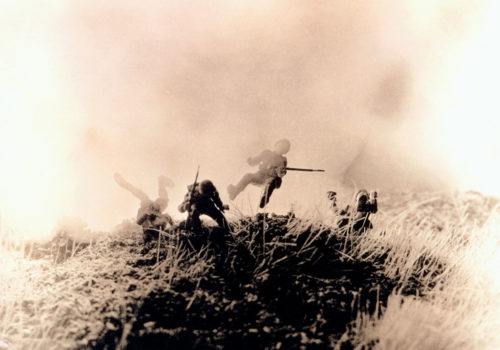“All art is propaganda,” George Orwell said, and we know this best through the study of art history itself. We reflect on a civilization’s achievements through its art, the creation of its greatest image of self through the sublimation of the life force. And what results is what remains, that which transcends time and place and speaks to in all languages at the same time.
“History is written by the victors,” it has been said, and it is in that space between art and history that we find the propagandist. We see in the work the message being told, sold, signed, sealed, and delivered, then, more often than not, consumed whole. We, moved the spirit that resides in the work itself, fall under the sway of its siren song as it captivates our heart with its soulful gaze.
Yet, in this day and age, when art has been liberated from the state, when it no longer serves to necessarily reinforce the power structure but to question and even destabilize it, the artist is a channel, a vessel for thought, for mediation and expression on subjects that are sometimes too heavy and too profound to be taken head on. And, in this way, David Levinthal has emerged as one of the foremost war photographers of our time, though he has never stepped foot on the battlefield itself.
War Games (Kehrer Verlag) is Levinthal’s newest book, which combines selections from five projects and early works with essays by Dave Hickey and Paul Roth, and the cumulative effect is nothing short of a revelation. Taken first, the title and cover alone, the reference to the toy figurines that dot Levinthal’s theater of war, alongside the very idea of war as a game, as toys that children play with as they grow from boys to men. Back in the days it began with these plastic toys; now these war games have taken on a new level of “reality” with a video component. But the essence of the game is always the same: war is something to be consumed for the pleasure of the kill and joy of defeating one’s imagined enemy.
In the theater of war, there is no right and wrong. There is no good and evil, but rather the organization of destruction as a means to exerting power over a rival or a threat. That t,here is mythology and ideology that surrounds this organization is the means to keep the engines of war in motion. War is an industry and it must be financed. The best way to keep things running smoothly is to generate moral support for the “good fight.” And a brilliant way to do this is to introduce to children the idea that war is a game and that they are on the side of right, and might is right, or so the battlefield declaims.
Levinthal’s photographs remind us of this, while simultaneously questioning the very construction of war and its propagandists. In his images we can never quite know who the good and bad guys are. Instead we are witness to acts we would like to assume are acts of heroism. We would like to believe that those who step on the battlefield are not merely pawns but those engaged by the powers that be, to give of their lives in the service of the country into which they are born. In Levinthal’s photographs, we no longer see the visceral horrors of battle as it is waged, but rather we are removed one step by the evidence of the constructed image to contemplate the metaphors of art, history, and war.
It is here in these constructions that we are freed from the unbearable burden of knowledge, we do not have to literally contemplate what it means to bear witness to acts of destruction of this magnitude. Lenvithal’s photographs are images of war as it has been fought in our age. It holds neither the strident heroicism of historic painting, or the glorification of action film, but rather recalls nothing so much as the best literature on the subject of war. Each photograph brings us inside a lyric, an epic poem, a tragedy upon the stage, each image silent and still yet alive with an energy that is ambivalent. This isn’t all fun and games—or is it?
Truth is in the eye of the beholder, alongside beauty, love, and hate. Do we ever comprehend war, the organized impulse towards violence, the orchestration of symphonies of slaughter, that are then reflected back into popular culture. Through art, through entertainment, through games, through toy figurines. through re-enacting that which we did not live, and which we have never seen, and there can only be one winner, and the look to each image carefully. And Levinthal provides no answers, or even questions. He simply offers us the possibility of clues.
http://www.artbooksheidelberg.de/html/detail/en/david-levinthal-978-3-86828-412-6.html
http://missrosen.wordpress.com
















